|
Displaying items by tag: Crystal Bridges
Back in 2013, the Crystal Bridges Museum of American Art in Bentonville, Arkansas, acquired Frank Lloyd Wright’s Bachman-Wilson House from architect/designer team Lawrence and Sharon Tarantino. The only catch was that the house was located 1,200 miles away in Millstone, New Jersey. Staff at Crystal Bridges quickly got to work devising a plan to disassemble, transport, and rebuild the house -- a stunning example of one of Wright’s iconic Usonian homes -- on the museum’s sprawling 120-acre campus. As the project nears completion, the museum has announced that it will officially unveil the structure to the public on November 11, 2015, the fourth anniversary of Crystal Bridges’ opening.
Wright designed the Bachman-Wilson House in 1954 for Abraham Wilson and his wife, Gloria Bachman, whose brother, Marvin Bachman, was an...
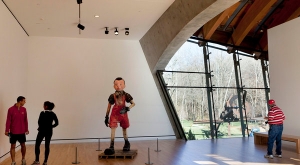
By just about any measure, the Crystal Bridges Museum of American Art, which opened last month in this small town in northwest Arkansas, is off to a running start. The dream-come-true of Alice Walton, an heir to the Walmart fortune, it is characterized by people both inside and outside the museum as a work in progress, with plenty of room for improvement. But there it stands, a big, serious, confident, new institution with more than 50,000 square feet of gallery space and a collection worth hundreds of millions of dollars in a region almost devoid of art museums.
Much more than just a demonstration of what money can buy or an attempt to burnish a rich family’s name, Crystal Bridges is poised to make a genuine cultural contribution, and possibly to become a place of pilgrimage for art lovers from around the world.
It came into being in record time: it was only in May 2005 that Ms. Walton announced the selection of the Israeli-born Boston architect Moshe Safdie to design the museum and ruffled feathers along the Eastern Seaboard by buying a landmark of Hudson River School landscape painting, “Kindred Spirits,” by Asher B. Durand, from the New York Public Library for around $35 million. The purchase came early in an extended shopping spree that rattled nerves, aroused skepticism and stimulated the art market.
Today Crystal Bridges has a spacious and comfortable, if rather coarsely detailed, home set into a beautiful ravine carved by the Crystal Spring, from whence comes the name. (The land was once part of the Walton family property in Bentonville, where Ms. Walton’s father, Sam Walton, opened his first five-and-dime in 1951.) And it has a collection, spanning colonial times to the present, substantial enough to merit the use of the word “masterworks” in the title of its opening exhibition. This display of more than 400 paintings, sculptures and works on paper includes efforts by revered artists like Gilbert Stuart, Thomas Cole and Thomas Eakins and is especially outstanding in its representation of early-20th-century Modernism, with wonderful clusters of paintings by Marsden Hartley and Stuart Davis and two fabulous canvases by Arthur Dove.
The museum also has the beginning of a distinctive mission, which is to tie together American art and history and the immediate experience of nature in a compelling and accessible way, one that still keeps the art very much in the foreground.
This mission seems built into Mr. Safdie’s design, which consists of eight linked pavilions that border or span two large pools that are fed by the spring (and that unfortunately were empty and still being worked on when I visited this month). In a way that seems slightly confused, the arrangement evokes aspects of the Getty’s hilltop campus in Los Angeles, of Frank Lloyd Wright’s Fallingwater in western Pennsylvania and of a fancy theme park, minus the rides.
But there is an undeniable brilliance to this physical dispersal; you are never far from the outdoors, never cocooned by a maze of galleries. Moving through the building becomes something of a tour of its remarkable setting.
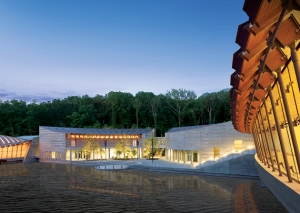
The opening of any major new American museum is news, especially when the museum has been designed by world-renowned architect, Moshe Safdie. But the opening of that museum in the heart of the Arkansas Ozarks sends reverberations through the art world.
Located in the heart of the nation, far from the urban art meccas of New York and Los Angeles, Crystal Bridges was founded by Alice Walton, daughter of Sam Walton of Walmart fame. The museum (Fig. 1) is situated at the bottom of a steep wooded ravine on a 120-acre park that was part of the Walton family’s original estate. Alice, who grew up roaming these woods, wanted a museum that worked in harmony with the surrounding forest, integrating the experience of art and nature for its visitors. A natural stream fed by Crystal Spring, which gives the museum its name, flows through the site and is spanned by two copper-roofed bridges housing galleries and the museum restaurant. The stream is dammed by weirs, producing two large ponds around which seven additional buildings are nestled.
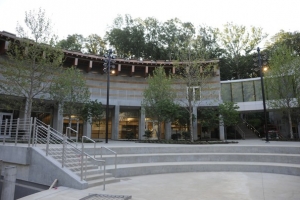
On Interstate 540 near Bentonville, a billboard shows what appears to be a wild circus costume, or an outlandish party dress for someone who stands about eight feet tall. It is a Soundsuit, a work by the contemporary African American artist Nick Cave, famous for his distinctive fabric sculptures covered in strange geegaws and decorative exotica.
It is also an advertisement for Crystal Bridges Museum of American Art, the most-talked-about new museum in the United States in a generation. Opening Nov. 11 in the corporate home town of Wal-Mart and a bedrock of Middle America, the museum has ruffled feathers, challenged stereotypes and raised expectations as this country’s newest major cultural institution. That it is announcing its debut to a presumably conservative local audience not with a classic Western landscape, or a meticulous portrait of a Founding Father, but with a work of contemporary sculpture, is a sign of its larger cultural ambition.
“Going against type is a big part of it,” says Crystal Bridges Executive Director Don Bacigalupi, who has been helping the fledgling museum beef up its contemporary art collection. As the museum prepares for a deluge of foreign and national media coverage, it’s easy to anticipate the ready-made story line: The oddity of a world-class art museum rising in Arkansas, with reflexive condescension about its focus on American art and its origins in the Wal-Mart corporate fortune.
But as workers put the finishing touches on the new building and curators oversaw the installation of art collected over decades by founder Alice L. Walton, a visit to the museum made it clear that Crystal Bridges intends to be taken seriously well beyond northwest Arkansas. It has not only gathered a synoptic view of American art, it will feature contemporary galleries and an extensive library, and its leaders profess no squeamishness about embracing all aspects of the canon, including the experimental and the controversial.
Endowed by the Walton Family Foundation with $800 million, Crystal Bridges instantly joins the ranks of the richest museums in this country, and it has been using its extraordinary resources to assemble a collection of American art that may rival in quality, if not quantity, anything available to museum visitors in New York, Washington, Los Angeles or Chicago. It has aggressively pursued some of the most prized and iconic pieces of American art to come on the market in the past five years, leading some observers to detect an impact on prices that they call the “Walton effect.”
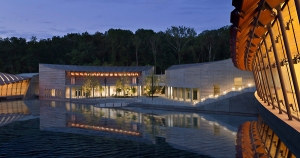
ON paper it resembles a subplot from David Foster Wallace’s deliriously satiric novel “Infinite Jest”: a billionaire heiress builds a spectacular art museum on family property somewhere in the Deep South and gives it the suspiciously New-Agey name Crystal Bridges. But this is nonfiction. On Nov. 11 Alice Walton, daughter of Wal-Mart founder Sam Walton, will unveil the Crystal Bridges Museum of American Art in the small city of Bentonville, Ark.
Ms. Walton will always be remembered by New York’s cultural custodians for absconding six years ago with Asher B. Durand’s “Kindred Spirits,” a key piece of Hudson River School painting. (The New York Public Library let it go for about $35 million.) But Ms. Walton, 61, is no harebrained carpetbagger. A serious, lifelong art collector, she intends to make Crystal Bridges a major comprehensive repository of American art from Colonial to contemporary. In 2005 she hired the distinguished art historian and former National Gallery of Art curator John Wilmerding to advise on acquisitions and went on a buying spree that netted a George Washington portrait by Gilbert Stuart; Norman Rockwell’s “Rosie the Riveter” (1943); Jasper Johns’s “Alphabets” (1960-62); and a 2009 portrait of Bill Clinton, a friend of Ms. Walton’s, by Chuck Close.
The 201,000-square-foot complex of retro-futuristic buildings designed by Moshe Safdie is set on 120 acres of forest and gardens, and it bridges a pair of ponds fed by nearby Crystal Spring. It may be remote, but with an $800 million endowment given by the Walton Family Foundation, Crystal Bridges promises to alter the landscape of art in America.
Meanwhile, in Denver, a much smaller but in some ways no less immodest institution, the Clyfford Still Museum, will open on Nov. 18. It is dedicated exclusively to the work of Still (1904-80) one of the most irascible of that prickly bunch of New York painters known as the Abstract Expressionists. His movie-screen-size canvases loaded with lushly colored paint applied in broad swaths interrupted by flamelike passages hold a much-honored place in the canon of American Modernism. But if they nevertheless have not gotten their due, it is because Still turned his back on the commercial gallery system in the early 1950s and rarely exhibited his work thereafter. His will stipulated that his entire estate of 2,400 works should be donated to an American city willing to give it a permanent home. In 2004 Still’s widow, Patricia Still, turned the estate over to Denver.
For its opening exhibition the museum will fill its 10,000 square-foot second-floor galleries with 110 paintings and drawings dating from 1920 to 1980. According to a museum news release the show will demonstrate that Still was on to pure abstraction in the early 1940s, in advance of his colleagues Pollock, de Kooning and Rothko.
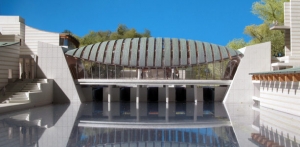
Crystal Bridges Museum of American Art in Bentonville announced Thursday that it won't charge admission for patrons to see what's promised to be one of the best art collections in the nation.
The museum will replace that revenue with a $20 million grant from Bentonville-based Wal-Mart Stores Inc., which will provide the money over five years. The museum had planned to charge $10 per person.
The museum is funded by the fortune of Wal-Mart heiress Alice Walton and has been outbidding top museums for acquisitions that will go on display to the public on Nov. 11.
Wal-Mart President and Chief Executive Officer Mike Duke said the world's largest retailer made the donation so its workers and the rest of the community could regularly enjoy the museum.
Crystal Bridges Executive Director Don Bacigalupi said the gift enables the museum to "become a daily resource in our community."
"One of the greatest challenges for museums today is finding ways to remove barriers to community participation, including admission charges," Bacigalupi said.
The museum and grounds, designed by architect Moshe Safdie, are expected to attract visitors from around the world.
Arkansas Parks and Tourism Department Director Joe David Rice said the free admission will help generate tourism from state residents and the larger surrounding area. Bentonville is in the far northwest corner of Arkansas, and Rice said free admission will help draw repeat visits from people on day trips from Tulsa, Okla., Springfield, Mo., southeast Kansas and other communities.
"We're trying to figure out exactly how big this is going to be up there," Rice said.
The Clinton Presidential Center in Little Rock turned the city's formerly desolate downtown into a thriving area with new hotels and office buildings, loft apartments, galleries, nightclubs and museums.
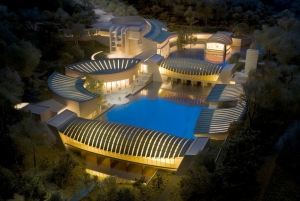
Just one week after kicking off its membership program, Crystal Bridges Museum of American Art has already welcomed 3,000 Original Members. “It’s a rewarding testimony to the excitement and anticipation of the Museum's opening on 11-11-11,” said Don Bacigalupi, Crystal Bridges executive director. “The response has exceeded our expectations. People are calling, faxing, mailing, emailing and using our website to purchase memberships. And it’s not slowing down.”
As the museum continues to receive additional members, the staff and volunteers want to show their appreciation for the outpouring of support.
“We have decided to extend the Nov. 9 members-only preview event to member number 3,001 and beyond by keeping the doors open 24 hours,” said Kathryn Roberts, director of member and guest services.
Every member will be notified in early fall about the process for securing their timed tickets for the preview. The initial 3,000 members will have the first opportunity to select their preferred time followed by subsequent Original Members.
Original Membership benefits apply through Nov. 30, 2012. Memberships can still be purchased by calling (479) 418-5728 or by visiting www.crystalbridges.org.
|
|
|
|
|